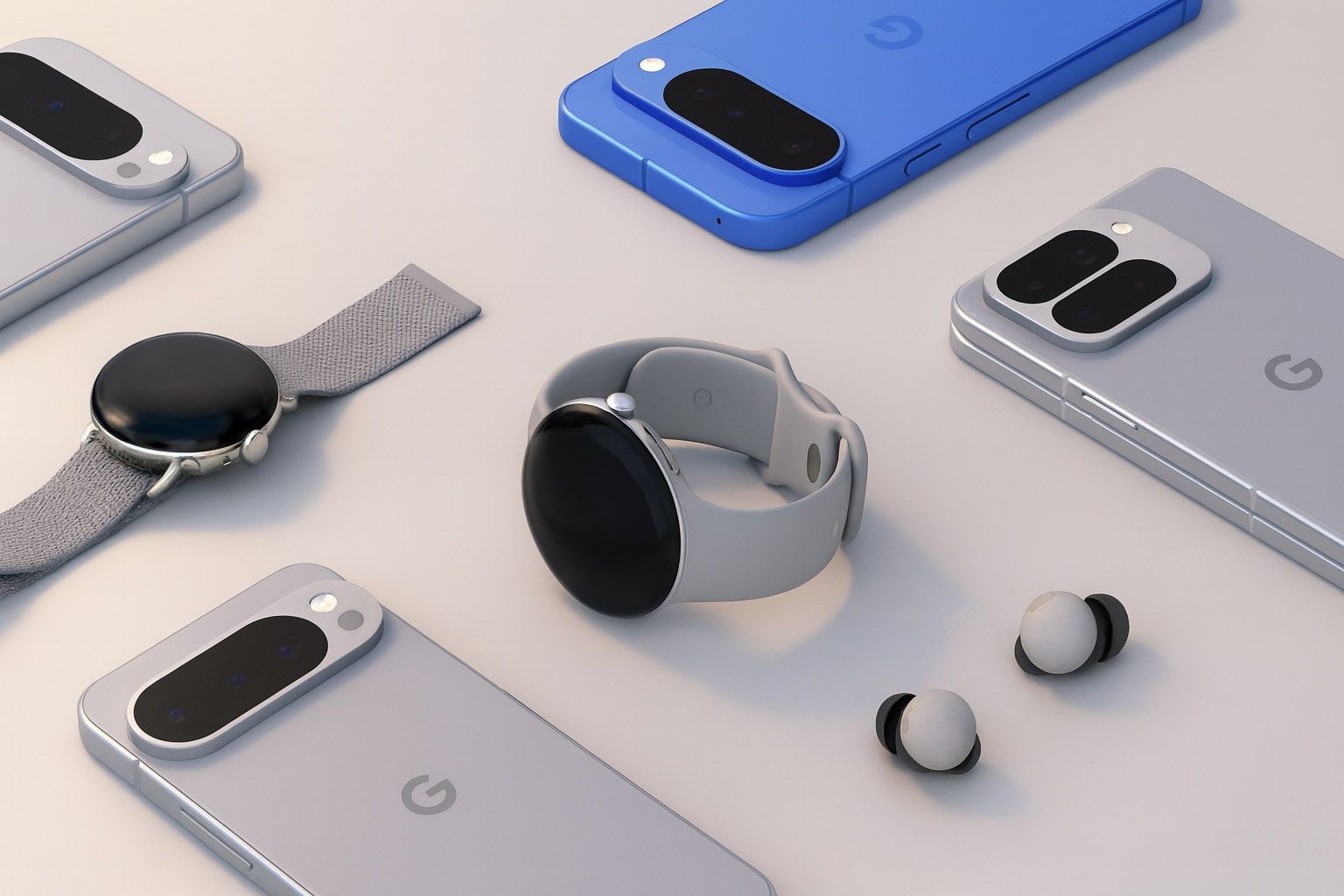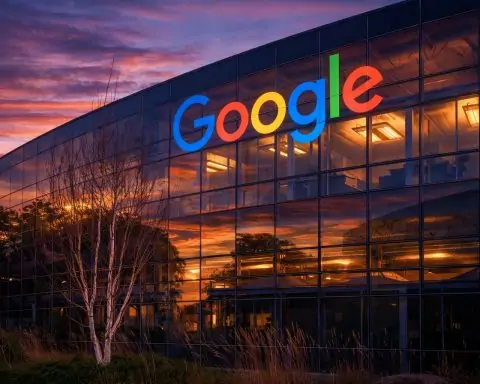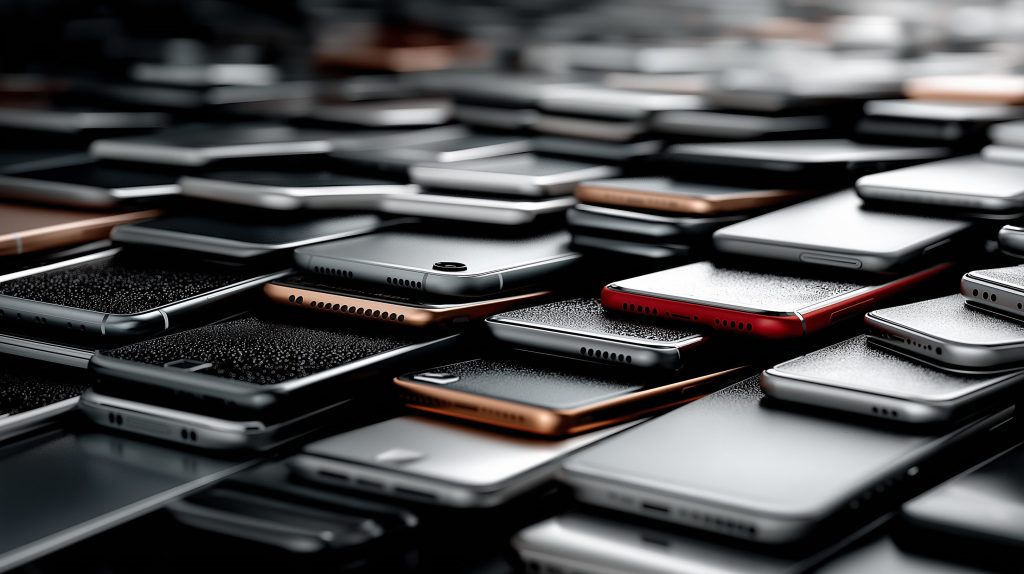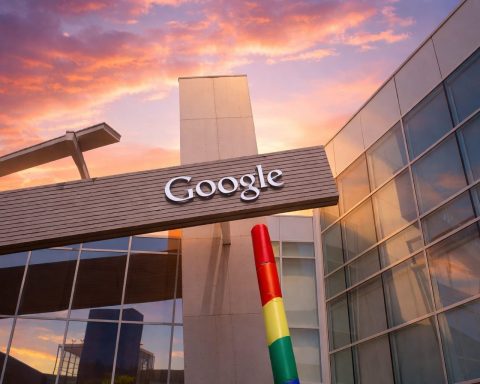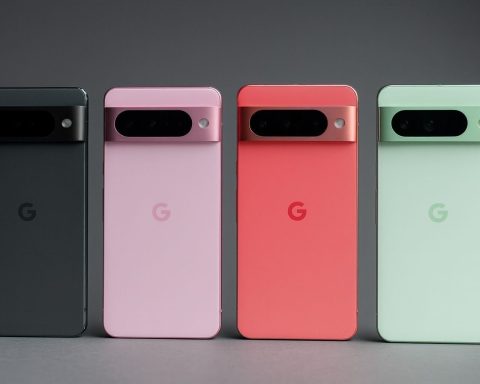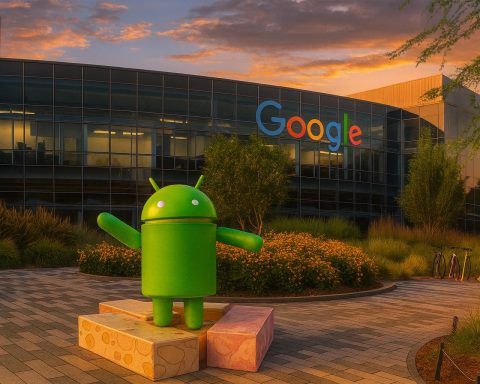- The Pixel 10 base model features a 6.3-inch Actua OLED display, 12 GB of RAM, the Tensor G5 chip, starts at $799, and ships on August 28.
- The Pixel 10 Pro and Pixel 10 Pro XL come with 16 GB RAM, 6.3-inch and 6.8-inch displays, a new periscope 100× Super Res Zoom, priced at $999 and $1,199 respectively, with preorder now and shipping on August 28.
- The Pixel 10 Pro Fold has a 6.4-inch outer display, an 8-inch inner display, gearless hinge, IP68 rating, 100,000+ fold cycles, costs $1,799, and ships October 9.
- All Pixel 10 models run on Google’s Tensor G5 with on-device Gemini Nano AI enabling Magic Cue, Camera Coach, and real-time 10-language Voice Translate, with a one-year Google AI Pro subscription bundled for the Pixel 10 Pro/Pro XL.
- The Pixel 10 base hits up to 3,000 nits and the Pros up to 3,300 nits, supports Qi2 wireless charging, and introduces Pixelsnap with a Magnetic stand ($69.99) or puck ($39.99) plus Cases ($49+) and a Ring Stand ($29.99).
- Pixel 10 phones can access emergency satellite SMS via carrier networks like T-Mobile, and the Pixel Watch gains Standalone Satellite SOS for on-wrist emergency connectivity.
- The Pixel Watch 4 is offered in 41 mm and 45 mm sizes, priced at $349 and $399, with up to 40 hours of battery life on, about 3 days with AOD off.
- It uses a Snapdragon W5 Gen 2 with a Google co-processor, adds Advanced Fitness and Health Tools with Fitbit, supports pulse loss detection, ECG and fall detection, and includes an AI Fitness Coach.
- Pixel Buds 2A are priced at $129, offer ANC and IP54, up to 20 hours of total battery with the charging case, and run on-device AI for real-time translation and voice commands.
- Pixel Buds Pro 2 remain $229, add a Moonstone color, and software updates for Adaptive Audio and head-gesture controls, while Reuters notes the hardware remains unchanged from last year.
Made by Google 2025: Big Hardware Reveals with an AI Twist
Google’s Made by Google 2025 event in New York City delivered a sweeping lineup of new gadgets – from the flagship Pixel 10 phones (including a surprise Pixel 10 Pro Fold foldable) to a revamped Pixel Watch 4 and refreshed Pixel Buds – all underpinned by Google’s latest AI innovations [1] [2]. This showcase, marking the tenth year of Google’s Pixel brand, highlighted how far Google’s hardware has come in blending cutting-edge specs with AI-driven features. As Google’s SVP of Devices Rick Osterloh put it on stage, “there has been a lot of hype and frankly a lot of broken promises” about AI in phones – but with its new Gemini AI model running on-device, Google believes “Gemini is the real deal” and will unlock “so much helpfulness” on these devices [3] [4]. Below, we break down everything announced – specs, features, pricing and availability – and how Google’s newest gear stacks up against Apple and Samsung’s best.
Pixel 10 Series: Flagship Phones Pack Upgrades and AI Smarts
Pixel 10 – Google’s standard flagship – steps up with a 6.3-inch Actua OLED display and, notably, a triple rear camera system (yes, even the base model now gains a telephoto lens) [5]. Backed by 12 GB of RAM and the new Tensor G5 chip, the Pixel 10 is primed for AI tasks and photography feats. It launches on August 28 starting at $799 [6]. The base Pixel 10’s addition of a telephoto camera brings it closer to parity with premium models, a direct challenge to rivals like Apple, which has historically reserved telephoto lenses for its Pro iPhones [7].
Pixel 10 Pro & Pixel 10 Pro XL – Google expanded its Pro lineup this year with two sizes. Both Pro variants sport beefed-up specs: 16 GB RAM and enhanced camera capabilities. The Pixel 10 Pro comes in the same handy 6.3-inch size as the base model, while the Pixel 10 Pro XL stretches to 6.8 inches for those craving a bigger screen [8] [9]. The Pro models introduce a new periscope zoom lens that achieves up to 100× Super Res Zoom using AI-powered image generation to restore detail in distant shots [10] [11]. (For context, last year’s Pixel maxed at 30× zoom, so this is a substantial leap.) Both Pro and Pro XL still feature triple cameras but with superior sensors and Google’s latest computational photography tricks. Despite the upgrades, Google held the line on prices – the Pixel 10 Pro starts at $999 and the Pro XL at $1,199, the same as last year’s models [12] [13]. All three Pixel 10 phones (base, Pro, and Pro XL) are available for preorder now and ship on August 28 [14].
Under the Hood – Tensor G5 and AI: The entire Pixel 10 family runs on Google’s in-house Tensor G5 processor built by TSMC, which Google says is 34% faster than its predecessor and includes a 60% more powerful AI engine for on-device machine learning [15] [16]. This chip enables Google’s new Gemini Nano AI to run locally, powering features like Magic Cue and Camera Coach without needing the cloud [17] [18]. In fact, Google is so confident in its AI capabilities that it’s bundling a one-year subscription to “Google AI Pro” with every Pixel 10 Pro/Pro XL (a service that normally costs ~$19/month) to give users access to advanced generative AI tools [19] [20]. Osterloh touted Google’s advantage here, saying “we’ve got the best models, we’ve got the best AI assistant” on these phones [21] – a not-so-subtle jab at Apple’s more limited Siri. New AI-driven features debuting with Pixel 10 include Magic Cue (a context-aware assistant that, for example, automatically surfaces your flight info on screen when you call an airline) [22] [23], Voice Translate for real-time call translations in 10 languages [24], and Camera Coach to guide your photo composition with on-screen tips [25]. Google is positioning these Pixels as proactive, “personalized and proactive” devices that anticipate user needs, rather than just react [26] [27].
Design and Features: Externally, the Pixel 10 phones retain Google’s signature look (matte glass, camera bar), but with some welcome tweaks. The displays are brighter than ever – up to 3,000 nits on the base model and 3,300 nits on the Pros, for improved outdoor visibility [28]. All models now finally support Qi2 wireless charging and a new magnetic accessory system called Pixelsnap, which works much like Apple’s MagSafe. This means you can snap the Pixel 10 onto magnetic wireless chargers, car mounts, and cases that align perfectly [29] [30]. Google introduced a suite of Pixelsnap gear, including a combo wireless charging stand, magnetic cases, and even a ring grip, signaling a new ecosystem of first-party accessories to enhance the Pixel experience [31] [32]. Another first for Google: expanded satellite connectivity. Pixel 10 phones can tap into emergency satellite SMS services when you’re off the grid, thanks to partnerships like T-Mobile’s emerging satellite network [33] [34]. (This mirrors Apple’s Emergency SOS via satellite, but Google’s approach works through carrier collaborations and even extends to the Pixel Watch – more on that below.) On the software side, the Pixel 10s launch with the latest Android (and will be among the first to get Android 15), with Google’s customary day-one updates and at least 5 years of security support.
Pixel 10 Pro Fold: Google’s Most Advanced (and Durable) Foldable
Google also pulled back the curtain on the Pixel 10 Pro Fold, its second-generation foldable phone that aims squarely at Samsung’s Galaxy Z Fold series. This time, Google isn’t treating the foldable as a standalone oddity – it’s branded as part of the Pixel 10 family (hence “Pro Fold”) and carries the same Tensor G5 chip and AI feature set as its siblings [35] [36]. The Pixel 10 Pro Fold features a 6.4-inch outer display and unfolds into a roomy 8-inch tablet display [37], slightly larger than its predecessor. Google says the new design uses a gearless hinge mechanism that’s built to endure over a decade of folds (so, 100,000+ open/close cycles) without failing [38]. Impressively, it’s also IP68-rated – meaning fully dust- and water-resistant [39] – a first for any foldable phone. (By comparison, even the latest Samsung Galaxy Fold is only IPX8, offering water protection but still vulnerable to dust ingress [40] [41]. Google’s achievement here could pressure Samsung, which just last year moved to an IP4X rating that keeps out sand grains >1 mm but not fine dust [42] [43]. With Pixel Fold, you truly don’t have to baby the phone around dirt or water.)
Multitasking is a core focus for the Pixel 10 Pro Fold. The big inner screen can run two apps side-by-side or let you drag-and-drop content between windows, making the device a productivity powerhouse [44]. Google demonstrated smooth transitions between folded and unfolded modes and optimized interfaces for popular apps. The Fold’s camera system is similar to the Pixel 10 Pro (triple lenses, including a periscope telephoto), so you don’t sacrifice imaging prowess for the form factor. And thanks to the hinge allowing various angles, you can use the Fold in “tabletop” mode for hands-free video calls or as its own tripod for photos. The Pixel 10 Pro Fold is decidedly high-end: it will cost $1,799 (same launch price as Samsung’s Fold) and ships a bit later – on October 9 with preorders open now [45]. Clearly, Google is positioning it as a technology showcase – blending the latest Android software tricks with hardware that challenges Samsung’s dominance in foldables. Early hands-on coverage praised the Fold’s sturdier build and refined design – and the added confidence that a bit of dust or rain won’t spell doom for this premium phone [46] [47].
Pixel Watch 4: Longer Battery, Smarter Coach, and Apple on Notice
Google’s Pixel Watch 4 made a splash as well, evolving Google’s smartwatch from a fashionable newcomer into a true Apple Watch competitor. For the first time, Google offers the Pixel Watch in two sizes – a 41 mm case (like the original) and a new larger 45 mm option – priced at $349 and $399 respectively [48]. Both use an elegant Actua 360 domed display that’s brighter than ever (peaking around 3,000 nits, on par with the latest Apple Watch displays) [49]. Looks aside, the headline improvement is battery life: Google promises up to 40 hours on a charge with the always-on display active (and around 3 days with AOD off) [50] – roughly double the endurance of last year’s model. In real terms, that means most users can get through two full days of use comfortably, a huge leap that addresses one of the Pixel Watch’s previous weaknesses and even surpasses the daily charging cycle of the Apple Watch [51] [52]. Contributing to this is a new dual-chip architecture: the Watch 4 runs on Qualcomm’s latest Snapdragon W5 Gen 2 processor paired with a bespoke Google co-processor for low-power tasks, yielding 25% faster performance at half the power draw compared to the last gen [53]. This is the same approach Apple uses (main CPU plus a companion chip) in its watches, and Google leveraging it now greatly boosts efficiency.
Health and safety features see significant upgrades. Pixel Watch 4 introduces Advanced Fitness and Health Tools developed with Fitbit’s expertise (Google owns Fitbit). It can now detect a loss of pulse and alert emergency services – essentially a form of cardiac arrest detection – joining features like ECG and fall detection [54]. An AI Fitness Coach is built in to provide personalized exercise guidance and wellness tips, using on-device AI to adapt to your habits [55]. Perhaps most eye-opening, the LTE version of Pixel Watch 4 supports Standalone Satellite SOS: if you’re in an emergency with no cell coverage, the watch can directly connect to satellites to call for help [56]. This is a first in the smartwatch arena (neither Apple nor Samsung watches have standalone satellite comms). It leverages some of the same tech as the Pixel phones’ satellite SMS feature, potentially giving peace of mind to hikers and adventurers. Google also touts fast charging on the new Watch – just 15 minutes of charge adds ~15 hours of use [57], so topping up is quicker than ever.
Taken together, these enhancements have some experts declaring that Google “just changed the smartwatch game” and put the Apple Watch on notice [58]. After a decade of Apple Watch dominance, the Pixel Watch 4’s multi-day battery and AI-driven features are “showing us the future of smartwatches,” as one tech reviewer gushed [59] [60]. The watch still runs Wear OS 4, with deep integration of Google services: you can get Assistant voice replies, turn-by-turn Maps directions, and even the new Gemini AI features like smart message replies and suggestions on the watch thanks to the Snapdragon W5’s machine learning prowess [61]. The Pixel Watch 4 will hit stores on October 9 (preorders are live) and comes with 6 months of Fitbit Premium and 3 months of YouTube Music bundled, similar to previous promotions [62]. For Android users eyeing an upgrade or iPhone users curious about switching, the Pixel Watch 4 represents Google’s strongest push yet into the wearable space.
Other Announcements: Pixel Buds 2A, Pixel Buds Pro Updates, and Pixel Accessories
Rounding out Google’s hardware announcements were new earbuds and a bevy of accessories designed to flesh out the Pixel ecosystem:
- Pixel Buds 2A – A new budget-friendly addition to Google’s earbuds, the Pixel Buds 2a slots in as the affordable A-series option (think of it as the Pixel A-series phone equivalent). Google promises “a premium experience at an exceptional value” with these wireless buds [63]. They feature Active Noise Cancellation and IP54 water resistance for workouts [64], and leverage on-device AI for features like real-time translation and voice commands via Assistant. Battery life is solid at up to 20 hours with the charging case [65]. The Pixel Buds 2A are priced at $129 and will be available on October 9 (preorders starting immediately) [66], making advanced features accessible at nearly half the cost of many premium earbuds.
- Pixel Buds Pro 2 – Google’s flagship earbuds are also getting some love, though not a full hardware overhaul. The Pixel Buds Pro (2nd gen) remain $229 and share the same hardware as last year, but Google announced a new chic “Moonstone” color to match the Pixel 10 phones, plus a forthcoming software update to enable new features [67] [68]. These include Adaptive Audio (automatically tuning noise cancellation and volume to your environment) and even a quirky gesture where you can answer calls by simply nodding your head (thanks to motion sensors) [69] [70]. While not a radical update, Google is showing commitment to its premium earbuds with iterative improvements – although Reuters noted Google “did not update the Pixel Buds Pro 2” hardware beyond the color, focusing instead on software enhancements for existing owners [71].
- Pixelsnap Magnetic Accessories – As mentioned earlier, Google is launching a whole line of first-party accessories under the Pixelsnap banner to complement the Pixel 10 phones’ new magnetic Qi charging support. These were briefly showcased at the event: a Pixelsnap Wireless Charger that doubles as a stand (priced at $69.99 with stand or $39.99 as a puck) [72], Pixelsnap Cases ($49+) that let you charge the phone without removing the case, and a nifty Pixelsnap Ring Stand ($29.99) that attaches to the back of the phone magnetically – serving as both a grip ring and a kickstand while also aligning with chargers [73]. Additionally, Google unveiled a high-speed 67W dual-port USB-C charger (the “Pixel Flex” charger, $60) which can fast-charge two devices at once and will prioritize power to a connected Pixel phone intelligently [74]. All these accessories hit the market on the Pixel 10 launch date (Aug. 28), signaling Google’s intent to build out an ecosystem much like Apple’s MagSafe accessory universe [75] [76]. It’s a “long-awaited” move that finally brings Pixels up to par with a convenience iPhones have had since 2020 [77].
Google’s Hardware Strategy: An AI-First Ecosystem
A clear theme ran through every announcement: Google is betting on AI as its ace card in the hardware race. Rather than spotlighting only speeds and feeds, Google devoted much of the event to demonstrating how Gemini AI makes Pixel devices more useful and “proactive” in daily life [78] [79]. This aligns with Google’s broader ambition to develop a “universal AI assistant” that spans all your devices [80]. Many of the Pixel 10’s new tricks – Magic Cue’s context awareness, Call Screen’s AI call summaries, Recorder app’s ability to generate music from a hum – showcase Google’s end-to-end integration of hardware, software, and AI services [81] [82]. “Our vision is to shift how technology works for you,” wrote Google’s devices VP in a blog post, saying Pixel should anticipate needs, “guide you to a better photo, guard you from spam and much more” – all while keeping personal data secure on-device [83] [84].
Crucially, Google’s control over the Tensor G5 chip allows it to optimize these AI features specifically for Pixel. The G5’s machine learning cores are dedicated to running the Gemini Nano model internally, enabling features like Magic Cue to operate privately without sending data to the cloud [85] [86]. This on-device AI focus differentiates Pixel from, say, Apple’s Siri (which currently relies heavily on cloud processing and has lagged in evolving with generative AI [87]). In fact, Google took direct aim at Apple during the event: Osterloh referenced “broken promises” in mobile AI, a not-so-veiled reference to Apple’s much-criticized delays in upgrading Siri with AI smarts [88]. He emphasized that Google’s approach – “we’ve got the best models” and “the best AI assistant” – enables Pixel to do things competitors cannot yet match [89]. One example is the Gemini Live feature on Pixel 10, which lets you have an interactive back-and-forth conversation about whatever is on your phone screen, almost like an AI concierge. It’s an evolution of Google Assistant that feels closer to ChatGPT, and Google is ahead of the pack in deploying this kind of on-device generative AI [90].
From a strategic perspective, Google seems to be leveraging Pixel hardware as a showcase for its software prowess. Industry analysts observed that while this year’s hardware changes were relatively modest (especially after last year’s bold redesign), the marketing focus was squarely on AI and new user experiences [91] [92]. “A lot of the stuff they showed today would probably run almost exactly the same on last year’s hardware. Their point is, it’s not about just the hardware anymore,” noted Bob O’Donnell, chief of Technalysis Research [93]. In other words, Google is signaling that the era of purely spec-driven upgrades is over – the real differentiator now is how intelligently your phone or watch can assist you. This strategy plays to Google’s strengths in software and cloud services, leveraging Pixel as the “true laboratory of innovation” for AI in consumer devices [94].
Pixel vs. The Competition: How Does Google Stack Up?
Google’s 2025 devices don’t exist in a vacuum – they’re aimed squarely at challenging Apple’s and Samsung’s dominance. Here’s how they compare:
- Smartphones – Pixel 10 vs iPhone and Galaxy: With the Pixel 10 lineup, Google is aggressively closing feature gaps. The base Pixel 10 at $799 undercuts the price of an iPhone 15/16 Pro yet now offers a telephoto camera and 120 Hz high-brightness display that even Apple’s base models lack [95] [96]. Google’s decision to hold prices flat in spite of inflation and tariff worries [97] [98] contrasts with competitors who have inched prices up. Samsung’s Galaxy S series will face a Pixel 10 Pro that matches or exceeds their specs: the Pixel 10 Pro’s 6.8″ screen and 100× zoom rival the Galaxy S25 Ultra’s rumored camera, and Google’s new Pro Res Zoom (which uses generative AI to enhance detail) is a direct answer to Samsung’s Space Zoom tricks [99]. On performance, Apple’s A-series chips still lead in raw horsepower, but Google is carving out an AI niche – many AI features on Pixel (like the call translator or Magic Cue) have no equivalent on iPhone yet [100] [101]. Apple’s iOS ecosystem is famously polished, but even some Apple insiders have noted the company “toned down” its AI promises recently after struggling to deliver features like an AI-smart Siri [102]. Google is capitalizing on that: the Pixel 10’s ability to proactively assist (e.g. showing your boarding pass as a notification at the airport) is something Apple is only just beginning to explore. On the other hand, Google still trails in custom silicon efficiency and graphics performance, which matter for gaming and some pro apps – areas where Apple and Qualcomm (in Samsung devices) maintain an edge. Still, in 2025 it’s clear AI is the new battleground, and as Mobile World Live noted, “Google currently owns a lead over rival Apple’s nascent attempts” in that arena [103].
- Foldables – Pixel 10 Pro Fold vs Galaxy Z Fold: Samsung practically invented the mainstream foldable with its Galaxy Z Fold line, now in its 6th/7th generation. Google’s freshman effort (the 2023 Pixel Fold) was praised for its camera but fell short in thickness and durability. The Pixel 10 Pro Fold aims to change that narrative. It adopts a taller 6.4″ cover screen, reportedly making it feel more like a regular phone when folded (a critique of the first Pixel Fold’s squat screen). Its 8″ inner display is on par with Samsung’s Fold. Critically, Google leapfrogged Samsung on durability – the Pixel Fold is the first foldable with full IP68 dust and water resistance [104], whereas Samsung’s latest Fold still isn’t dust-tight (only IPX8 or IP48 as of 2024) [105] [106]. This could be a significant selling point for buyers who worry about the long-term toughness of foldables. Moreover, Google’s hinge improvements promise a less visible crease and longer lifespan, addressing a common Galaxy Fold complaint. In software, both Pixel Fold and Galaxy Fold run Android, but Google’s version is Pixel-optimized with neat tricks like live translation across the split screens and automatic camera framing in tent mode. Samsung’s Fold has the advantage of years of refinement and features like S-Pen support (which Pixel Fold lacks). Price-wise, they’re neck and neck at ~$1,799. Ultimately, Pixel 10 Pro Fold stands as a serious alternative to Samsung’s Fold – especially for users who prioritize camera quality (Pixel’s camera algorithms often outperform Samsung’s) and a cleaner Android experience. It’s also a statement that Google is committed to this form factor and willing to push the envelope – a healthy competition that should spur faster innovation in foldables across the industry.
- Wearables – Pixel Watch 4 vs Apple Watch vs Galaxy Watch: The smartwatch arena has been Apple’s kingdom (with over 30% market share worldwide), but Google is steadily advancing. The Pixel Watch 4’s improvements in battery life directly target one of Apple Watch’s pain points – needing daily charging [107] [108]. With 2+ days of battery, Pixel Watch 4 even outlasts the premium Apple Watch Ultra (which manages about 36 hours) in typical use. Google’s adoption of the Snapdragon W5 Gen 2 also brings it to parity in performance with Samsung’s Galaxy Watch 6, since Samsung co-developed that chip. Where Google tries to pull ahead is with AI and health features: the Pixel Watch 4’s AI Health Coach and on-device Assistant integration aim to be smarter and more helpful than Apple’s current approach (which relies on a paired iPhone for advanced Siri queries). Additionally, Pixel Watch offers deep Fitbit integration (for fitness tracking and community challenges) and now emergency satellite SOS on-wrist – neither of which Apple or Samsung offer [109]. Apple still holds advantages like a more mature app ecosystem for watchOS and tight hardware-software synergy, but Google is closing the gap significantly. One tech analyst noted that Pixel Watch 4’s comprehensive upgrade shows Google “positioning on-device AI more effectively than any of its rivals” in wearables [110]. Meanwhile, Samsung’s Galaxy Watch (which also runs Wear OS) will face competition from Pixel Watch on its own turf. Samsung’s watches typically have slightly more health sensors (like body composition measurement) and come in at lower pricing, but Pixel Watch 4’s battery gains and polished design might sway Android users who want the best Google experience. The competition in 2025 is fierce, but for the first time, reviewers are seriously saying “move over, Apple Watch” – the Pixel Watch 4 shows Android smartwatches can not only catch up but even lead in certain aspects [111] [112].
- Audio & Accessories: In the earbuds space, Google’s new Pixel Buds 2A undercut Apple’s AirPods and Samsung’s Galaxy Buds on price while offering many similar features (ANC, water resistance). They lack the bespoke spatial audio of AirPods Pro, but at $129 they’re appealing to budget buyers in the Android ecosystem. The Pixel Buds Pro (with upcoming updates like head-gesture controls) continue to compete with high-end AirPods Pro and Galaxy Buds Pro; they’re well-regarded for sound quality and hands-free Assistant, though Apple’s seamless device switching and Samsung’s 24-bit audio support are differentiators. On accessories, Google’s belated embrace of a MagSafe-like system (Pixelsnap) acknowledges the success Apple has had building an accessory ecosystem. It levels the playing field for Pixel users who can now enjoy the convenience of magnetic mounts and wireless charging that click perfectly into place [113]. Samsung has its own ecosystem of cases and chargers but has not invested in a magnetic system on phones (its wireless charging is standard Qi). So Google is actually ahead of Samsung here by adopting Qi2 with magnets, making Pixel 10 series the first major Android phones with this capability [114].
Early Reactions and Outlook
The tech community’s response to Google’s announcements has been largely positive, especially regarding the AI features. Leo Gebbie, principal analyst at CCS Insight, remarked that this was “Google’s most comprehensive and wide-ranging hardware update ever” and that Google is now “arguably positioning on-device AI more effectively than any of its rivals” [115] [116]. He noted the Magic Cue feature as an exciting step toward the long-promised “agentic AI” future of smartphones, while praising the overall Pixel portfolio strength as “more attractive than ever to both returning and new customers” [117] [118]. In short, Google’s execution this year impressed many observers who in the past saw Pixel hardware as inconsistent. Another analyst, Carolina Milanesi of Creative Strategies, pointed out that last year Google wowed with a bold hardware redesign, whereas “this [year] feels more like a big push from a marketing perspective” to broaden Pixel’s appeal beyond the tech enthusiast niche [119]. Indeed, Google announced it will expand Pixel sales to new markets like Mexico for the first time [120] – a move analysts have long urged, given Pixel’s very limited country availability has stunted its market share. “I hope this is the start of expanding their channel presence,” Milanesi said, noting that Google’s addressable market is still a limiting factor on Pixel’s growth [121].
Pixel’s market share remains a challenge: globally it’s around 1.1% (up from 0.9% a year ago) and about 4% in the U.S., according to IDC data – far behind Apple and Samsung [122]. Google’s hardware push is partly about demonstrating the best of Android to the world (and to its Android partners). As Reuters observed, the annual Pixel event serves to “show off to device makers and developers the potential of Android” as much as to sell Pixels directly [123]. In that sense, Pixel can succeed by influencing the broader ecosystem (for example, expect other Android brands to adopt some of Google’s AI features down the line). But Google clearly also wants to sell more of its own devices now. With a stronger product lineup than ever, the big question is whether Google will market them aggressively and expand distribution. “The real question is how ambitious Google wants to be here,” said analyst Leo Gebbie. “With a more aggressive approach, there is no reason why Pixel devices could not pick up a far greater market share. However, Google has always seemed content using its hardware as a means to launch software features and to keep its [Android] partners honest.” [124] In other words, Pixel’s role has historically been to push the envelope rather than become a mainstream bestseller. It remains to be seen if 2025 is the year that changes.
Not every review was glowing – a TechCrunch editor quipped that parts of Google’s presentation were a “cringefest,” underselling the tech with awkward scripted banter [125]. (Google even brought in comedian Jimmy Fallon to co-host the event in Brooklyn, an unconventional move that had mixed reactions [126].) But even skeptics agree the hardware itself is Google’s best yet. The combination of iterative hardware improvements and ambitious AI-centric features has set Google’s devices apart in a crowded field. “It’s not about the hardware anymore,” as Google insists – it’s about what the hardware can do for you. By tightly integrating its services and AI into Pixel phones, watches, and beyond, Google is playing a different game than simply spec one-upmanship.
Bottom Line
Google’s Made by Google 2025 event showcased a tech giant confident in its vision: an AI-powered personal tech ecosystem that competes head-on with Apple and Samsung. The Pixel 10 series, with its blend of solid hardware upgrades and unique AI abilities, is positioned as a true Android tour de force [127] [128]. The Pixel Watch 4 addresses past shortcomings and even leapfrogs competitors in battery and safety features. And the Pixel 10 Pro Fold proves Google is in the foldable race to win it, bringing welcome competition to Samsung.
For consumers, these announcements are exciting news – whether you’re considering jumping to Pixel for the first time or upgrading from an older model, Google is offering more choices (and more form factors) than ever. Importantly, Google isn’t just adding more gadgets for the sake of it; it’s leveraging its prowess in AI to make using these devices feel more intuitive, seamless, and yes, helpful. As Osterloh confidently stated on stage, “we’ve got the best AI assistant” on Pixel now [129] – and with these new releases, Google is making a strong case that its hardware finally has the whole package to match that claim. The real test will be in the coming months: if consumers respond and Pixel’s market share surges even modestly, it will validate Google’s AI-first, ecosystem-centric strategy. Either way, Google has undeniably raised the stakes in the smartphone, foldable, and smartwatch arenas, and its rivals will be under pressure to answer. The ultimate winners here should be the users, who can expect faster innovation and smarter features across the board as the AI hardware race heats up.
Sources: Google/Alphabet Event Announcements and Blog [130] [131] [132] [133]; CNET/Reuters news reports and analysis [134] [135] [136]; eWeek and MobileWorldLive coverage for specs and features [137] [138]; Expert commentary from analysts at Reuters & Mobile World Live [139] [140]; PhoneArena and AndroidAuthority for competitive context [141] [142].
References
1. www.eweek.com, 2. www.reuters.com, 3. www.reuters.com, 4. www.reuters.com, 5. www.reuters.com, 6. www.eweek.com, 7. www.reuters.com, 8. www.eweek.com, 9. www.eweek.com, 10. www.mobileworldlive.com, 11. www.mobileworldlive.com, 12. www.eweek.com, 13. www.reuters.com, 14. www.mobileworldlive.com, 15. www.mobileworldlive.com, 16. www.mobileworldlive.com, 17. www.eweek.com, 18. www.eweek.com, 19. www.mobileworldlive.com, 20. www.eweek.com, 21. www.reuters.com, 22. www.mobileworldlive.com, 23. www.reuters.com, 24. www.eweek.com, 25. www.mobileworldlive.com, 26. blog.google, 27. blog.google, 28. www.mobileworldlive.com, 29. www.reuters.com, 30. www.eweek.com, 31. www.eweek.com, 32. www.eweek.com, 33. www.eweek.com, 34. www.mobileworldlive.com, 35. www.eweek.com, 36. www.reuters.com, 37. www.eweek.com, 38. www.eweek.com, 39. www.eweek.com, 40. www.eweek.com, 41. www.androidauthority.com, 42. www.androidauthority.com, 43. www.androidauthority.com, 44. www.eweek.com, 45. www.eweek.com, 46. www.eweek.com, 47. www.reuters.com, 48. www.eweek.com, 49. www.mobileworldlive.com, 50. www.phonearena.com, 51. www.phonearena.com, 52. www.eweek.com, 53. www.phonearena.com, 54. www.eweek.com, 55. www.mobileworldlive.com, 56. www.mobileworldlive.com, 57. www.eweek.com, 58. www.phonearena.com, 59. www.phonearena.com, 60. www.phonearena.com, 61. www.mobileworldlive.com, 62. www.eweek.com, 63. blog.google, 64. www.eweek.com, 65. www.eweek.com, 66. www.eweek.com, 67. blog.google, 68. www.reuters.com, 69. www.eweek.com, 70. www.eweek.com, 71. www.reuters.com, 72. www.eweek.com, 73. www.eweek.com, 74. www.eweek.com, 75. www.eweek.com, 76. www.reuters.com, 77. www.reuters.com, 78. blog.google, 79. www.reuters.com, 80. www.reuters.com, 81. www.eweek.com, 82. www.eweek.com, 83. blog.google, 84. blog.google, 85. www.mobileworldlive.com, 86. www.mobileworldlive.com, 87. www.reuters.com, 88. www.reuters.com, 89. www.reuters.com, 90. www.mobileworldlive.com, 91. www.reuters.com, 92. www.reuters.com, 93. www.reuters.com, 94. tech.yahoo.com, 95. www.reuters.com, 96. www.mobileworldlive.com, 97. www.reuters.com, 98. www.reuters.com, 99. www.mobileworldlive.com, 100. www.reuters.com, 101. www.mobileworldlive.com, 102. www.reuters.com, 103. www.mobileworldlive.com, 104. www.eweek.com, 105. www.androidauthority.com, 106. www.androidauthority.com, 107. www.phonearena.com, 108. www.phonearena.com, 109. www.mobileworldlive.com, 110. www.mobileworldlive.com, 111. www.phonearena.com, 112. www.phonearena.com, 113. www.reuters.com, 114. www.eweek.com, 115. www.mobileworldlive.com, 116. www.mobileworldlive.com, 117. www.mobileworldlive.com, 118. www.mobileworldlive.com, 119. www.reuters.com, 120. www.reuters.com, 121. www.reuters.com, 122. www.reuters.com, 123. www.reuters.com, 124. www.mobileworldlive.com, 125. wasubo.com, 126. www.reuters.com, 127. www.reuters.com, 128. www.mobileworldlive.com, 129. www.reuters.com, 130. www.eweek.com, 131. www.eweek.com, 132. www.eweek.com, 133. blog.google, 134. www.reuters.com, 135. www.reuters.com, 136. www.reuters.com, 137. www.eweek.com, 138. www.mobileworldlive.com, 139. www.reuters.com, 140. www.mobileworldlive.com, 141. www.androidauthority.com, 142. www.phonearena.com
